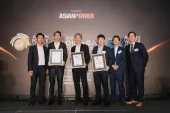
Energy Strat Asia's Tim Rockell stresses significance of unifying energy policy frameworks for Asian power markets
Rockell’s observations shed light on emerging technologies like hydrogen, biofuels, and nuclear energy, as well as policy initiatives driving electric vehicle adoption and innovations in hard-to-decarbonise sectors.
The energy industry, particularly in the context of the Asian oil and gas sector, is undergoing a significant transformation driven by the need for sustainable energy and the integration of new technologies.
Tim Rockell, the Managing Director of Energy Strat Asia Pte. Ltd., brings a wealth of experience and expertise in this field. With a background spanning over two decades, Rockell's journey in the energy sector has been marked by his dynamic leadership and impactful roles. He founded Energy Strat Asia in 2019, aiming to foster innovation and growth in energy services and technology companies across Singapore and Southeast Asia.
Amongst his extensive involvements are roles such as Management Board Member of the Energy Studies Institute at the National University of Singapore, Vice Chairman of the Energy Institute (UK) Singapore Branch Committee, and Chairman of the British Chamber of Commerce’s Energy & Utilities Business Committee.
In this interview, Rockell's insights offered a glimpse into the intricate dynamics shaping the energy industry, particularly in the context of the Asian oil and gas sector. He highlighted the strides being made in sustainable energy development and market integration across the region.
The Asia Pacific region is undergoing a significant energy transition. How do you see the role of sustainable energy development and market integration in driving this transition, and what opportunities do you see in the region for such developments?
Let’s start by reminding ourselves that Asia Pacific is a region of demographic and geographic contrasts, spanning half the globe. I’d like to focus the bulk of my comments on Southeast Asia where sustainable energy has a sizeable overall share of the power sector—around 33% according to IRENA—thanks largely to the region’s hydropower capacity. Renewables in the form of solar PV rollouts by the public and private sectors are well underway. We are starting to see more wind projects in the pipeline in countries including Vietnam, which is developing a service sector to build and operate these offshore projects. Alternative energies such as hydrogen, biofuels, and nuclear (in that order) are gaining attention, as are policy movements in the areas of electric vehicle adoption and research in hard-to-decarbonise sectors such as aviation and shipping. Carbon capture as standalone projects are on the drawing board, but in their early days in Asia. However, fossil fuel dependence in the wider energy system remains stubbornly entrenched.
Collaboration and partnerships are crucial for addressing complex energy challenges. Based on your experience, what factors contribute to the success of collaborations in the Asian oil and gas sector, where different stakeholders are involved in reaching sustainable energy goals?
I hear calls for “more collaboration” a lot at energy conferences. It seems to have been forgotten that the energy industry is one of the most collaborative sectors, whether through joint ventures or shared use of infrastructure. Energy is a sector where parties contribute to their strengths, whether it’s technology, market access, capital, or skills.
An interesting example is the creation of an ASEAN power market. This will increase energy security and enable more renewable electrons to reach end customers. If we are to develop a true power market across the region, we need to look at developing regional-based regulation that ensures electricity will flow unhindered across borders by connecting into transmission lines and trade in wholesale markets. This will encourage private investment in the necessary infrastructure development at scale.
Currently, policy at the national level is focused on either electricity imports or exports, depending on which end of the interconnector a government sits. More could be done at a regional policy level to ensure additional projects come onstream. The ASEAN region needs to scale its renewable energy generation capacity. The ten countries forming ASEAN are working together, and the ASEAN Centre for Energy, based out of Jakarta, along with other think tanks in the region, has an excellent grasp on the data and direction of pathways ahead. More should be done at the bloc level to bring together the early stage bi- and multilateral agreements that have been negotiated.
The energy industry is constantly evolving, driven by emerging technologies. In your opinion, what are some of the most promising emerging technologies that can have a significant impact on the energy sector in Asia, and how can these technologies be better utilised to drive sustainable energy development?
Challenges for sustainable energy remain, including ongoing cost competition from traditional energy sources, competition in wholesale energy markets, and transitioning in the hard-to-abate industrial and transportation sectors that are growing in this region. This means that policies will be needed with publicly funded projects to establish momentum in areas such as developing a hydrogen economy or carbon capture at an increasing scale.
The world has managed to create several two-word phrases that are easy to push out on social media or to provide soundbites at hustings but are very difficult to achieve. “Energy-transition” is one, “Net-zero” is another, and one more example is “Battery-recycling” when discussing electric vehicles.
Energy sector decarbonisation challenges are often not of a technical nature but price/economic and thus policy-based. Academic-industrial partnerships are needed to develop and bring the latest technology to market, and the government must have a strong end-to-end role to enable this. It’s important that these partnerships are techno-economic based. Often, I see engineers commissioning reports from other engineers to tell them what they already know. That is great confirmation, but it does not move the needle in terms of market development for alternative solutions.
Creating a Hydrogen-Economy—two more words that often go together—has challenges of providing low-carbon hydrogen, which can be done at a cost, with green hydrogen (produced from renewables) at roughly five times the price of grey hydrogen (from gas). New technologies such as that by Singapore and Melbourne-based electrolyser producer SunGreenH2 using nanostructured advanced materials that double hydrogen production with 10% reduced opex and importantly, 30 times reduced Platinum group metals that form the core components inside the electrolysers.
The Asian oil and gas industry is witnessing a rapid growth in renewable energy projects and technologies. From your perspective, what are the major hurdles or barriers that need to be overcome to accelerate the adoption of renewable energy sources and achieve a sustainable energy mix in the region?
I spoke at a politics and policy framework session at the recent Energy Asia conference. From my point of view, that was the most important session of the conference because every conference that I have attended recently has spoken of the need for governments to regulate, governments to ensure level playing fields, and governments to (re)direct subsidies.
In this region, we are not politically or market structured as the United States of ASEAN or the Southeast Asia Union as in the Western Hemisphere. Most regional policy in this region is done on a bilateral or multilateral basis. ASEAN is playing its role, and so too is the G20. Singapore, where I am based, has an important role acting as G20 sherpa across many of the smaller economy countries that are not represented directly on the G20. If we can establish a common framework using the best and most adaptable parts of these bilateral and multilateral agreements for creating Asian electricity markets that can be adopted as regional policy framework templates, that would be an important first step.
Energy transition requires substantial investments and financial support. What strategies or mechanisms can be employed to attract more private sector investment into sustainable energy projects in Asia? Are there any innovative financing models or partnerships that you believe could be replicated successfully in the region?
The subregion of Southeast Asia where I am based out of Singapore has decarbonisation challenges of growing urbanisation and industrialisation. Almost 4 trillion dollars of GDP and 680 million people are based in this region with real GDP growth of 4.6% and inflation of 4.6% in 2023, according to the IMF. In Southeast Asia, according to the IEA, 4% of the Asia Pacific population is without access to electricity. That compares to 10% globally, but there are two countries in Southeast Asia, Cambodia and Myanmar, where much more work has to be done.
Data is important. The Energy Institute is another source, through the Statistical Review of Energy which is published annually. Data science skills to analyse data are going to be increasingly important for policymakers and energy producers to predict demand, improve operations, and build better supplier-customer interactions. I am working with a company called Valuer.ai from Denmark that is providing AI-based global innovation opportunity mapping for clients, including many energy customers.
It is important that the Southeast Asian region crowds in innovation and funding for needed infrastructure. When you look at the data for infrastructure in this region, the trajectory is always one way—upward! However, this region needs to ensure that it makes capital available with regulations that are attractive to international investment and funding. I mentioned at the top of this article that there are 770 million people globally without access to electricity. The numbers will fall in Southeast Asia, but I suspect that global groups like the G20, COP, etc. will see their attention focused on Sub-Saharan Africa, where the number of people without electricity access has actually increased. Sub-Saharan Africa’s share of the global population without access to electricity rose to 77% from 74% before the pandemic, according to the IEA. So this region needs to make its case for funding.
As a judge at the Asian Oil & Gas Awards, what qualities do you look for when evaluating nominees?
It is always a pleasure reviewing entries. The ones that get my attention are those that explain very simply what problem they are solving or challenges the team has overcome, how they went about a project, and what makes them unique. I then look for evidence to back up statements and claims on the entry forms. This could be diagrams, drawings, or photographs. Corporate brochures are not the best format for substantiating your application – note to future entrants. Good luck to all the entrants who have proven that the sector is vibrant and innovative in Asia.



















 Advertise
Advertise






